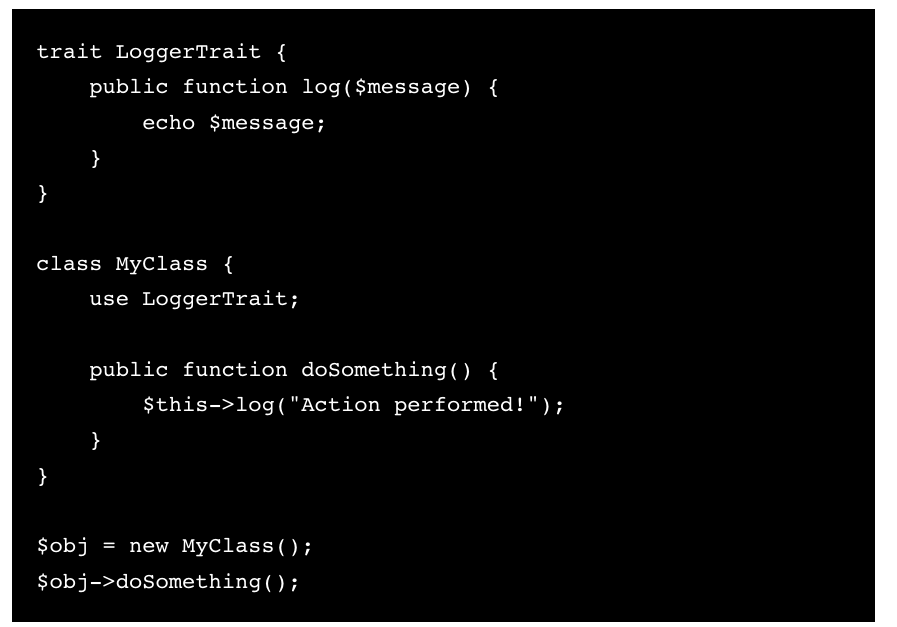PHP traits are a powerful feature that allow developers to reuse methods across different classes, avoiding the limitations of single inheritance. However, traits come with their own set of challenges, such as potential naming conflicts and confusion regarding code structure. If you’ve ever wondered whether there are better alternatives to using PHP traits, the answer is yes! In this blog post, we’ll dive into some practical alternatives to traits and how they can be used to achieve clean, reusable, and maintainable code.
What are PHP Traits?
Before we explore alternatives, let’s briefly revisit what PHP traits are. A trait is a mechanism for code reuse in PHP that allows you to group functionality in a single unit and then “insert” that functionality into multiple classes. Traits provide an elegant solution when you need to share common methods across classes that don’t share a direct inheritance relationship.
Example of a PHP trait:
trait LoggerTrait {
public function log($message) {
echo $message;
}
}
class MyClass {
use LoggerTrait;
public function doSomething() {
$this->log("Action performed!");
}
}
$obj = new MyClass();
$obj->doSomething();While traits are useful in some cases, they aren’t the perfect solution for every scenario. Traits introduce a form of code duplication by allowing methods to be reused, and they can lead to problems when combining multiple traits that define similar methods. Moreover, they don’t handle object relationships as neatly as other approaches might.
Now, let’s take a look at some alternatives to PHP traits that you can use to improve your code structure and reusability.
1. Composition Over Inheritance
Composition is often considered a more flexible alternative to inheritance (and by extension, traits) for code reuse. Rather than relying on inheritance or traits to provide functionality, composition involves embedding objects of other classes as properties within a class. These embedded objects handle specific tasks, and you delegate the work to them.
Example:
class Logger {
public function log($message) {
echo $message;
}
}
class MyClass {
private $logger;
public function __construct(Logger $logger) {
$this->logger = $logger;
}
public function doSomething() {
$this->logger->log("Action performed!");
}
}
$logger = new Logger();
$myClass = new MyClass($logger);
$myClass->doSomething();In this example, the MyClass class does not inherit or use a trait for logging functionality. Instead, it receives a Logger object via dependency injection and delegates the logging task to it. This approach allows you to reuse the Logger class without tightly coupling it to MyClass, promoting better separation of concerns.
Benefits of Composition:
- Flexibility: You can mix and match different components without worrying about inheritance constraints.
- Loose Coupling: Changes to one component (e.g.,
Logger) don’t directly affect others (e.g.,MyClass). - Testability: Composition makes it easier to mock or replace dependencies in tests.
2. Abstract Classes
Abstract classes can be an alternative to traits when you need to share common functionality among related classes. While traits allow for method sharing across any class, abstract classes provide a more structured approach where classes share common logic but still maintain the ability to have their own specific implementations.
An abstract class allows you to define shared behavior and requires child classes to implement certain methods.
Example:
abstract class Logger {
public function log($message) {
echo $message;
}
}
class MyClass extends Logger {
public function doSomething() {
$this->log("Action performed!");
}
}
$myClass = new MyClass();
$myClass->doSomething();Here, Logger is an abstract class, and MyClass inherits from it. The log() method is shared between all child classes, but each child class can define its own additional methods.
Benefits of Abstract Classes:
- Code Structure: Abstract classes provide a more structured way of organizing shared behavior.
- Single Inheritance: If you’re dealing with a single inheritance structure and need to ensure certain methods are always present, abstract classes can help enforce that.
- Centralized Logic: Common logic can be written once in an abstract class and inherited by multiple subclasses.
3. Interfaces and Dependency Injection
Another powerful alternative is using interfaces combined with dependency injection. An interface defines a contract that classes must follow, ensuring that all classes that implement it share a set of methods. Through dependency injection, you can inject different implementations of the same interface, allowing you to reuse functionality without relying on inheritance or traits.
Example:
interface LoggerInterface {
public function log($message);
}
class FileLogger implements LoggerInterface {
public function log($message) {
echo "File log: " . $message;
}
}
class MyClass {
private $logger;
public function __construct(LoggerInterface $logger) {
$this->logger = $logger;
}
public function doSomething() {
$this->logger->log("Action performed!");
}
}
$logger = new FileLogger();
$myClass = new MyClass($logger);
$myClass->doSomething();In this example, MyClass doesn’t depend on a concrete Logger class but on a LoggerInterface, which is implemented by any class (like FileLogger). The flexibility of this approach comes from the fact that you can inject different types of Logger into MyClass without modifying the class itself.
Benefits of Interfaces and Dependency Injection:
- Loose Coupling: Classes are not tightly coupled to specific implementations but instead interact through interfaces.
- Testability: It’s easy to mock interfaces in unit tests, allowing for more isolated testing.
- Flexibility: Different implementations of the same interface can be injected as needed.
4. Helper Functions/Global Functions
For utility-like functions that don’t necessarily need to belong to a class, you might want to use helper functions or global functions. This approach is commonly used for simple, stateless methods that don’t require object-oriented structures.
Example:
// Global helper function
function logMessage($message) {
echo $message;
}
class MyClass {
public function doSomething() {
logMessage("Action performed!");
}
}
$myClass = new MyClass();
$myClass->doSomething();In this case, we use a global function logMessage() to handle the logging. While this may not be appropriate for all scenarios, it works well for simple functionality that doesn’t require the overhead of object-oriented patterns.
Benefits of Helper Functions:
- Simplicity: For quick and easy reuse of simple functions, this can be a straightforward solution.
- Statelessness: Helper functions often don’t require the complexity of classes or objects.
- Global Access: They can be accessed from anywhere in your application.
5. Delegation
Delegation involves transferring responsibility for a task to another object, typically in the form of composition. This pattern allows classes to rely on other objects to perform specific tasks, instead of using inheritance or traits.
Example:
class Logger {
public function log($message) {
echo $message;
}
}
class MyClass {
private $logger;
public function __construct() {
$this->logger = new Logger();
}
public function doSomething() {
$this->logger->log("Action performed!");
}
}
$myClass = new MyClass();
$myClass->doSomething();In this example, MyClass delegates the logging responsibility to the Logger class. This is similar to composition but emphasizes that MyClass doesn’t perform logging itself—it delegates that task.
Benefits of Delegation:
- Loose Coupling:
MyClassdoesn’t have to worry about the details of logging. - Reusability: The
Loggerclass can be reused across various parts of your application. - Clear Responsibility: Each class has a clear responsibility, making the code easier to maintain.
Conclusion
PHP traits are a great tool for reusing code across multiple classes, but they aren’t always the best choice for every situation. Alternatives like composition, abstract classes, interfaces with dependency injection, helper functions, and delegation provide developers with more flexibility and cleaner code. Depending on your specific use case, these alternatives can lead to better maintainability, testability, and scalability in your PHP applications.
When deciding whether to use traits or one of these alternatives, think about the needs of your application. Do you need flexibility and decoupling? Or is code reuse your primary concern? By weighing the trade-offs of each approach, you’ll be able to choose the best solution for your project.


Leave a Reply